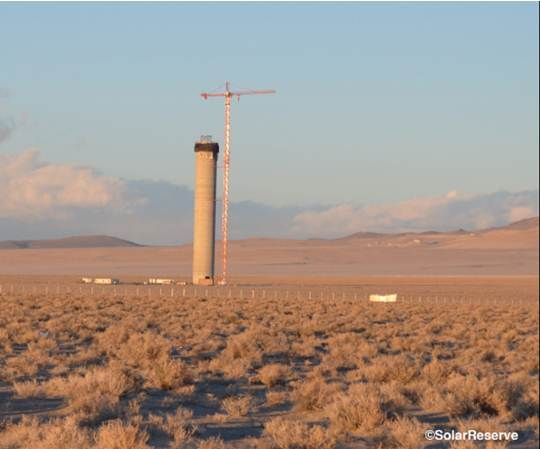With approval of the Environmental Impact Review on its 200-megawatt, two-tower Saguache Solar Energy Project, SolarReserve hopes to soon get started on a new pair of solar power tower/molten salt storage facilities.
“This is the major environmental permit,” SolarReserve CEO Kevin Smith said. “The bigger issue, in order to start construction, is we need to secure an offtaker.”
SolarReserve’s flagship 110-megawatt Crescent Dunes Solar Energy Plant in Nevada has a power purchase agreement (PPA) with Nevada Power and is under construction and scheduled to come on-line at the end of 2013.
In the wake of 2011’s dramatic drop in photovoltaic (PV) prices, institutional interest in solar thermal utility-scale solar power plant projects has declined. “We used to say that PV is intermittent, solar thermal without storage is intermittent, but solar thermal is cheaper,” Smith recalled, but “PV prices have come down dramatically, so unless you have storage with solar thermal, they might as well buy PV.”
Smith, however, is confident of a PPA for Saguache, named for the Colorado county where it will be built.
“My development philosophy has been to find good projects and permit them out front and then market them,” he said. “We did the same thing in Nevada and we were almost fully permitted in California when we signed our power contract,” he said of the PPA with PG&E for SolarReserve’s 150-megawatt Rice project.
SolarReserve’s PPA with Nevada Power pays 13.5 cents per kilowatt-hour and escalates one percent per year. That nearly matches, Smith said, Nevada’s thirteen-cent average retail electricity price.
“Keep in mind that this is project one and handcrafted,” Smith said. “Our goal is to bring the price down and we’re making headway.”

The varying nameplate capacities of these projects demonstrate how storage technology makes capacity more flexible and more valuable.
“On an annual basis,” Smith said, both the Nevada and California projects will “generate 500,000 megawatt-hours.” But, he explained, “the question is, how does the utility want us to deliver it? Do they want us to deliver 150 megawatts for ten or twelve hours a day? Or do they want us to send them 100 megawatts for fourteen or sixteen hours a day?”
The storage tank and steam turbine sizes, he said, dictate “whether we squeeze 150 megawatts out onto the transmission system for a shorter amount of time or stretch it out a bit. We could do a 75-megawatt project that runs twenty-four hours a day. Same 500,000 megawatt-hours.”
Crescent Dunes, Smith noted, “because of [the nature of] Las Vegas, is expected to run to eleven or twelve o’clock at night. But there’s not a lot of load in Las Vegas in the morning. They don’t want us to start generating electricity until twelve or one in the afternoon.”
In SolarReserve’s system, heliostats surrounding the tower direct the sun to a heat exchanger at the tower’s top. That 1,000-degree-Fahrenheit heat is transferred to a molten salt fluid flowing. After flowing through the fluid, the heat can then either flow to a water boiler to create steam to drive a turbine that generates electricity or to a storage tank, where it can be stored until there is a need for electricity.
“We’re collecting the energy directly into the storage fluid,” Smith said. Competitors have more limited storage capabilities because they “utilize water to run up the tower.”
According to Smith, BrightSource Energy, SolarReserve’s prominent U.S. solar power tower competitor, “is looking to extend the day a little bit by adding a couple of hours of storage.”
BrightSource Energy spokesperson Keely Wachs agreed there is a difference in the two companies’ storage technologies but said the BrightSource method, which uses water heated in the tower to heat molten salts for storage, also has substantial storage capabilities. Noting that BrightSource is presently in an SEC-mandated quiet period in anticipation of its upcoming initial public offering, Wachs said the company would be able to detail its technology at length afterwards.
SolarReserve’s Smith insisted his company’s storage method is “less expensive, more efficient, more technically challenging, and technically superior.” It is, he said, “the world’s leading solution for solar energy storage.”
Concerns about chemicals in the molten salts, which are part of what goes into common fertilizer, are misplaced, Smith said. “Permitting in California is about as difficult as you will see anywhere,” he explained, adding that the process “made it clear there were no dangers associated with using molten salts.”
Each of Saguache’s two 100-megawatt tower facilities is expected to create more than 450 direct jobs at the peak of the 30-month construction and 45 to 50 permanent jobs. The project’s annual budget will be an estimated $10 million and is expected to generate more than $30 million in local revenues.
Like its competitors, SolarReserve has incorporated the newest dry cooling methods into its facilities to reduce water consumption. The Saguache project will be built on private agricultural land, which, according to SolarReserve, currently draws 8,800 acre-feet (2.9 billion gallons) of water from the aquifer. Each of the two power tower facilities, according to the company, will use only 150 acre-feet of water per year.
The disadvantage to dry cooling, studies have shown, is that it is more costly than traditional wet cooling methods. But since most solar thermal companies are being forced by water conservation concerns to turn to it, only builders of PV projects, which can offer no significant storage, gain a competitive advantage.



